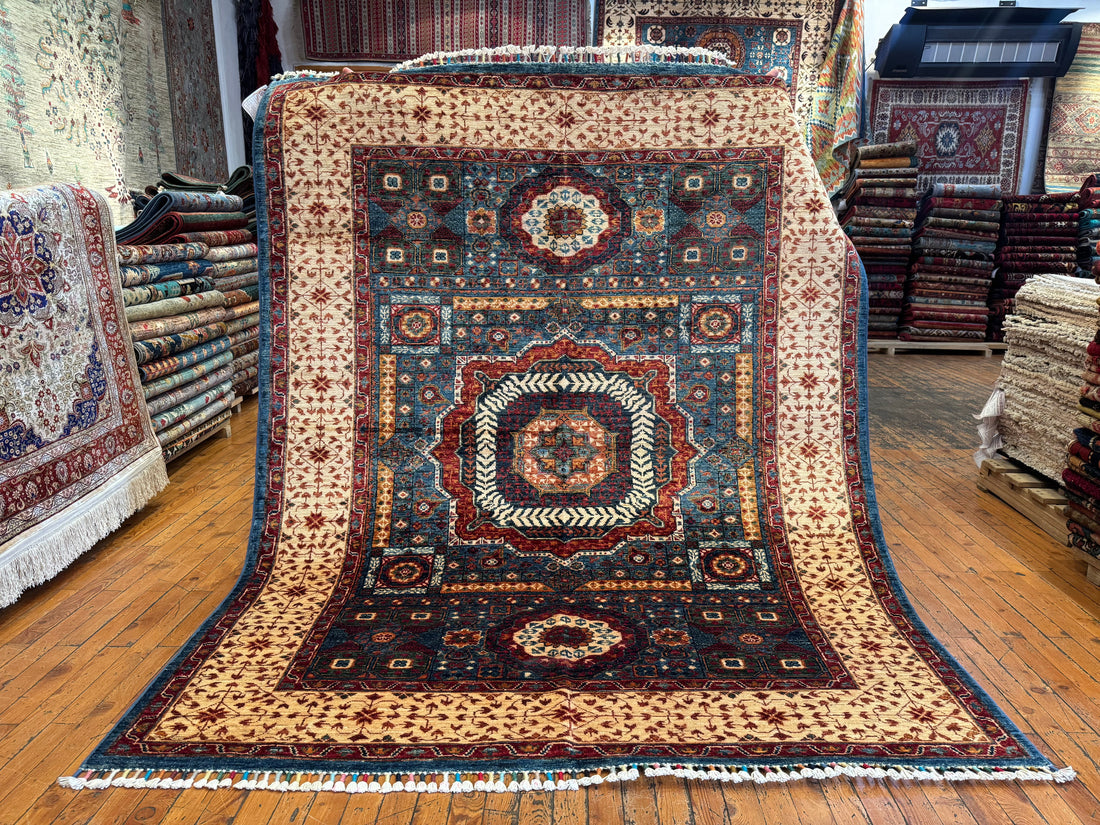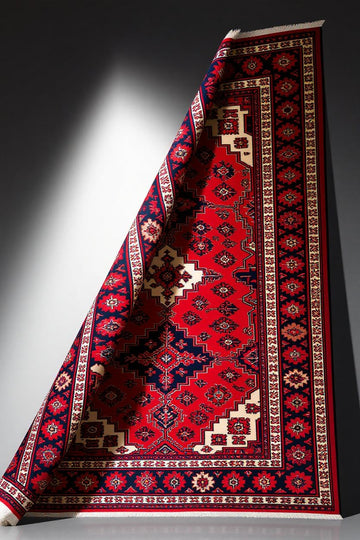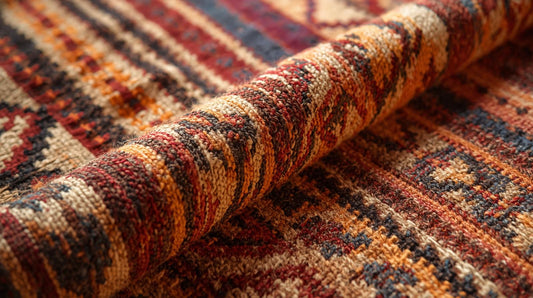How to Extend the Life of Handwoven Rugs

Every handwoven rug is a work of art and an investment in craftsmanship . Their natural fibers and dyes give warmth and character to a home, but also require careful upkeep. Proper care prevents premature wear, keeps colors vibrant, and preserves your rug’s value and beauty for decades. With the right routine, even heirloom-quality wool or silk rugs can last a lifetime. Neglect can cause irreversible damage, so it pays to learn a few simple care principles now. Our guide below – informed by rug-care experts – will help interior designers, rug enthusiasts, and homeowners protect their investment.
Best Practices for Regular Maintenance
Vacuum routinely. Remove dust and grit at least weekly with a suction-only vacuum (or one with the beater bar turned off) to avoid pulling on fibers. High-traffic rugs should be vacuumed more often (even twice a week) to keep abrasive dirt from settling into the pile. Always vacuum in the direction of the pile, and be gentle on fringes and flatweaves.
Blot spills immediately. When accidents happen, act fast: blot liquids with a clean, white cloth or paper towel (never scrub).
-
Start at the spill’s edge and work inward so the stain doesn’t spread. For solid debris, let it dry first then vacuum or gently brush it away.
- Use mild cleaning agents. For stains on wool or silk, mix a small amount of gentle, pH-neutral soap (for example, diluted Woolite or a specialized wool cleaner) in lukewarm water. Apply sparingly with a clean cloth, then blot dry. Avoid over-wetting – excess moisture can “brown” wool fibers and do not use harsh detergents or bleach, which can fade dyes Always spot-test in an inconspicuous area first.
- Handle natural fibers carefully. Wool rugs contain lanolin, which helps resist stains, but they still benefit from gentle care .Silk rugs are durable yet more delicate: vacuum them on the lowest setting and use cold water only for spot cleaning. For jute, cotton, or other natural flatweaves, avoid liquids altogether – treat spills with dry methods (baking soda or a dry shampoo) before vacuuming. In all cases, professional cleaning (once a year or so) is recommended to refresh the rug without riskç
Protecting Rugs from Sunlight and Traffic
Rug Pads and Rotation in Preservation
Use a quality rug pad under every area rug. A dense felt or rubber-backed pad should be cut just slightly smaller than the rug. Rug pads act as shock absorbers – they cushion the rug against foot traffic, prevent slipping and bunching, and reduce friction between rug and floor. This greatly extends a rug’s life by minimizing wear. Citizenry echoes this advice: “We always advise using a rug pad…[which] helps prevent everyday slipping and sliding”. Avoid cheap PVC pads that can discolor floor finishes.
In addition to pads, rotate your rugs (as noted above). Rotating changes the area of the rug that bears the brunt of footsteps or sunlight, evening out any wearing and fading. Ephesus recommends turning rugs 180° every 6–12 months, noting that this also “helps prevent fading from sunlight exposure”. Combined, proper padding and regular rotation are simple, effective ways to preserve pattern and pile.
Cleaning Different Handwoven Materials
-
Wool: The most common handwoven material, wool is sturdy and naturally stain-resistant (thanks to lanolin), but it still needs gentle care. Vacuum in low suction to lift dust, and clean spills with a wool-friendly soap solution. The Rug Company advises spot-cleaning wool with pH-neutral liquid soap and lukewarm water, blotting gently and avoiding excess moisture to prevent browning. Mud should be allowed to dry and then brushed off before spot treatment. For tough stains (wine, dye, etc.), leave it to the pros.
-
Silk: Handwoven silk rugs are luxurious yet surprisingly durable. Still, always vacuum silk on the gentlest setting (or using a soft brush attachment) to avoid crushing the shine. Clean spills with cold water only, in very small amounts. The Rug Company warns that silk must not be overwet, and suggests spot-cleaning like wool but with minimal cold water. If the fibers feel stiff after cleaning, lightly brush them back into place. In general, avoid scrubbing or any chemicals – for significant stains on silk, professional cleaning is safest.
-
Cotton and Jute: Rugs made of cotton or jute yarn (or blends) can shed loose fibers early on – this is normal and helps when you vacuum it up. These flatweaves should be vacuumed regularly but never scrubbed with liquid. For stains, use dry methods: sprinkle baking soda or dry rug shampoo, let it absorb the spill, then vacuum. Avoid harsh cleaners or soaking these natural fibers, as they can warp or break down. When in doubt, call a professional cleaner experienced in natural-fiber rugs.
Seasonal Care and Storage
-
Seasonal humidity: Adjust your care by the weather. In humid seasons, keep good air circulation (ceiling fans or dehumidifiers) to prevent mold. In dry months, avoid excessively low indoor humidity, which can make wool and silk fibers brittle. Don’t store rugs on damp floors or in unventilated basements.
-
Cleaning before storage: Always clean a rug before storing it long-term. Thoroughly vacuum or have it professionally cleaned so that no dirt, oils or pests remain. Let the rug dry completely – any residual moisture can lead to mildew.
-
How to store: Roll rugs, don’t fold them, with the pile (knotted side) facing inward. Wrap the roll in breathable material (cotton sheets or a rag), never plastic or non-porous coverings. (Plastic traps moisture and invites mildew.) For large rugs, storing them upright against a wall in a cool, dry spot is best. Keep stored rugs off the floor (place on shelves or pallets) to protect them from potential flooding. Store away from sunlight to prevent fading.
-
Pest prevention: Natural fibers attract moths. Add cedar blocks, lavender sachets, or natural moth repellent near the stored rug. Check on stored rugs monthly: unroll and inspect for any signs of pests, moisture, or creases. Flipping the rug every so often in storage helps equalize any long-term pressure.
Signs Your Rug Needs Professional Care
Sometimes routine care isn’t enough. Watch for warning signs that it’s time to call in professionals for deep cleaning or repair:
-
Persistent stains or odors: If a spill or pet accident leaves a stain or smell that won’t lift with gentle cleaning, it’s time for expert care. A truly clean rug should have no lingering sour or musty odors. Rug specialists have deep-cleaning equipment and enzymes that can remove embedded dirt or urine that home methods can’t.
-
Visible wear and damage: Frayed edges, threadbare spots, holes or tears in the pile are red flags. Left unchecked, small rips and worn areas can unravel further. Carpet restoration experts can re-weave fringes, patch holes, or reinforce edges. For example, Thomas Rug Cleaning notes that any discoloration, rip or frayed edge “is a cause for concern” needing professional assessment.
-
Signs of pests: Finding a moth, beetle larvae, or “sand” (tiny casings) under your rug means insects are eating the fibers. Call an expert immediately – they can treat the rug safely and advise on preventing re-infestation. Moths can multiply rapidly, so early action preserves the rug’s integrity.
Whenever you notice these issues – or if more than a year has passed since your last professional cleaning – don’t delay. Regular expert cleaning (about once a year) is recommended by many rug authorities. This renews the rug’s fibers and protects your investment over the long haul.
In short, proper care routines and prompt professional help when needed will ensure your handwoven rug remains as striking as the day you bought it. Our store’s rug specialists are always available to answer questions or assist with premium cleaning services. From gentle annual cleanings to expert repair work, we help you preserve the beauty and value of your rugs. We also carry a curated collection of new handwoven treasures – stop by or contact us anytime for personalized advice on rug care or to find the perfect piece for your space. Your home deserves the very best, and we’re here to provide it.
No comments







0 comments